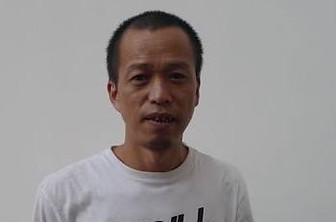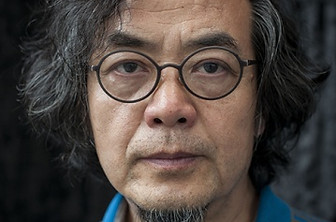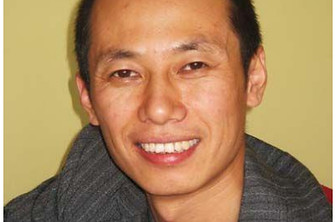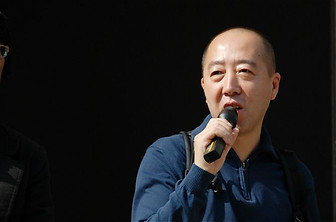“New Historical Drama” is an exhibition comprised of classic historical works, as well as current happenings and contemporary adaptations. The name comes from a series of operas depicting historical figures and events written after the establishment of the People’s Republic in 1949. This new form required playwrights to take a scientific view of history. They had to “excel at screening, analyzing, and utilizing related historical materials or legends. They also had to make fair and reasonable use of their artistic imaginations to shape vivid and lifelike artistic figures and make authentic combinations of historical and artistic truth. They had to make the past serve the present.”
 Wind Horse Flag No12 220 x 80 x 330 cm 2008 |  Backflow 8 '38'' Single Channel Video 6 editions 2011 |  195806 33 mins Video 3/3 edition 2015 |
|---|


Cai Dongdong
Born in Tianshu, Gansu, in 1978, Cai Dongdong joined the People’s Liberation Army at a young age, taking up a role as a portrait photographer for enlisted soldiers. This job became his formal training in the medium, developing into a career path as he returned to Beijing and opened his own studio. Through the use of archival, found photography, and installation, Cai creates half-fragmented realities. Taking readymade materials – a nod to Duchamp's Dadaist sensibilities – he pierces through the skin of these photographs with mirrors, arrows, and other objects, forming what he calls 'photo-sculptures.'
Cai currently lives and works in Beijing.
Fang Lijun
Fang Lijun (Chinese, b.1963) is a painter and printmaker associated with the Cynical Realist movement, and best known for his hyper-realistic paintings that criticize contemporary cultural values in China. Born in Handan, Hebei province, Fang studied printmaking at the Central Academy of Fine Arts in Beijing, where he was trained in the Socialist Realist style promoted during the Cultural Revolution. As part of the Cynical Realist movement, Fang rejected the political subject matter of Socialist Realism, but his work has retained the technical skill and realistic style of his training. He incorporates imagery from pop culture, folk art, and traditional Chinese painting, and his work often features bald, aggressive-looking figures. His painting 30th Mary (2006) is characteristic of his humor and cynicism; the work depicts bald figures wearing colorful school uniforms, floating in a tunnel of clouds, in a composition that evokes European religious paintings. Fang has also worked in the traditional practice of woodblock printing, putting together several scrolls to create large-scale prints. In all of his work, he examines the role of individual creativity in the oppressive cultural environment of modern China. He has held solo exhibitions at at the China Art Museum in Beijing, the Today Art Museum in Beijing, and the Staatliche Museen in Berlin. He lives and works in Beijing.

Feng Mengbo
Feng Mengbo is a self-described “video game artist” who uses new media and technology to explore Chinese iconography and history. He began his career with a suite of paintings, “Game Over: Long March” (1993), that depicts the adventures of a fictional Red Army character in a series of “game snapshots” reminiscent of Nintendo’s Super Mario (the title is a reference to the famed military retreat that precipitated Mao’s rise to power). Feng took this interest to a logical extreme, creating the interactive game Long March: Restart in 2008 using the same main character. Controlled by visitors, the soldier travels along an 80-by-20-foot digital scroll, projected on a gallery wall. The piece was shown at MoMA PS1 in 2010-2011. in recent years, he has begun to feel increasingly drawn towards traditional Chinese painting and calligraphy.

Guan Huaibin
Guan Huaibin graduated from Zhejiang Academy of Fine Arts (now China Academy of Art) in 1989. In 2004, he graduated with Ph.D. degree from Tokyo Art University. He now lives in Hangzhou, China. He teaches as a professor of China Academy of Art and is the Dean of School of Intermedia Art.
In the field of Chinese contemporary art, Guan Huabing adopts elements of traditional culture, which is dissolved into his own language system and the structure of his works. He integrates the aesthetics of ancient Chinese gardening into the shape of the space for his installations. His works are always overflowing with a different quality and temperament for Chinese modern art. From this we can see the strong humanist feeling and mood of his work, he makes use of elements of traditional Chinese culture within the context of modern art to achieve broad and extensive developments.

He Yunchang
He most committed and challenging performance artist of China, He Yunchang (b. 1967) has performed and exhibited worldwide. In his intimate and cathartic performances, psychological and physical stamina gains existential significance. In Dialog with Water (1999), he attempted over 90 minutes to cut a river into two halves with a knife while hanging upside-down from a crane; in Wrestling: One and One Hundred (2001), he wrestled consecutively with a hundred people over 66 minutes; in Casting (2004), he sealed himself inside a concrete block for 24 hours. Elsewhere, he undertakes journeys of self-discovery and returns psychologically transformed. In The Rock Tours Around Great Britain (September 24, 2006 - January 14, 2007), he carried a rock from Boulmer, on the northeastern coast of England, and returned it there after walking 3,500 kilometers counterclockwise along the perimeter of Britain. In Dream of Traveling—From Fukuoka Asian Art Museum to Mount Fuji (2009), he gradually emerged from a pile of 999 rocks while painting on each of them the imaginary routes of a spiritual ascension.

Li Songhua
Li Songhua was born in 1959 in Beijing, China. He always utilizes unique materials in his sculptures and installations, then conduct these materials with traditional methods and special techniques. For instance, he would use two irrelevant materials to create one single work at the same time, such as copper and feather. Most of his inspirations come from ancient myth, yet he prefers to employ modern style, which is time sensitive, to express his ideas. He had been showed at various exhibitions worldwide, including “The Second Triennial of Chinese Art”, The Nanjing Museum, Nanjing, China, 2005; “China Gold”, Contemporary Chinese Art, Museum of Maillol, Paris, France, 2008; and “CONFRONTING ANITYA—Oriental experience in contemporary art”, Venice, Italy, 2013. He currently lives and works in Beijing.

Qin Ga
Qin Ga frequents uses materials that contains energy; visible or invisible, such as steel plates, oil barrel, ice, wok, electric wire, gas tank, combustion, electricity, coal briquettes, sexual impulses, body temperature, and fear. As well as having dissection as part of the creation. The power created by the materials put Qin’s piece in the dynamic field. However, power is not what Qin cares about, it’s the conflict and dangerous between power and bodies that he concerns.

Song Yonghong
After graduating from the Department of Print-making at the China Academy of Fine Arts in 1988, Song Yonghong moved to Beijing where he took part in two landmark exhibitions, China Avant-Garde (1989) at the China Art Gallery and The New Generation’ (1991) at the Museum of Chinese History (see Yin Ji’nan).
Bringing the techniques of etching to oil painting, Song’s canvases are inhabited by people, objects and scenes executed with sharp edges and solid colours. They either lack or possess well-defined and heavy shadows. Such treatment, together with the puppet-like movements of the characters—often portrayed as lost in sexual desires—communicates a strong sense of disorientation.

Sui Jianguo
Sui Jianguo (b. 1956, Qingdao, China) received a BA in the Fine Arts Department from the Shandong University of Arts in 1984 and an MA in the Sculpture Department from the China Central Academy of Fine Arts in 1989, where he currently presides as the Head of the Sculpture Department. He has been praised by art critics for being a “pioneer venturing to the farthest reaches of Chinese sculpture.” Sui Jianguo’s art explores his unique understanding and recognition of creation, form, diverse media, alternative methods, and space-time. Sui Jianguo’s sculpture succeeds in bringing forth introspection on the artistic process in modern China. Whether it be the Realism in his early works or the classic shapes in his later Mao Jacket and Dinosaur pieces, both rely on the wisdom of native Chinese genealogy and channels of culture to serve as ways to solve problems, functioning as outlets.

Wang Du
b.1956 Wuhan, China
Wang Du was born in Wuhan in December 1956. He has lived and worked in Paris since 1990. He has taught in the art department at the University of Paris VIII and the École supérieure d'art de Brest. Wang Du works in a range of media, including installation, sculpture, photography, and multi-media. His statement, “I am media, I am reality, I am image,” could be seen as an interpretation of the concepts behind his work. He believes that “the completely digital third reality is constructing a contemporary society and culture that needs to be constantly redefined.” Thus, his work redefines a series of concepts within reality from different perspectives, which is also the statement he has made since he declared, “I am the spokesperson for reality and the masses.”
Wang’s art has been disseminated widely in art criticism, documentaries, contemporary artist dictionaries, and art books. His work has also been covered by many international magazines, newspapers, and TV and radio stations. In 2008 and 2012, Wang Du held solo exhibitions at Tang Contemporary Art in Beijing, titled “International Kebab” and “Musée d’Art Contemporain de la Chine” respectively. His works have been exhibited throughout international museums and contemporary art institutions including the 1999 Venice Biennale, Centre Pompidou, Musée National d’Art Moderne in Paris, Vancouver Art Gallery, Rodin Gallery in South Korea, San Francisco Museum of Modern Art, Deitch Projects in New York, Kestnergesellschaft in Hanover, Germany.

Wang Ningde
Wang Ningde graduated from Luxun Art Academy and have been transforming from a documentary photographer to an artist. Through exploring the concepts of temporality and memories, his practice investigates the properties of time, history and memories. He recently revisits the basic theories of photography and applies them into his recent works, which question critically on images authenticity and validity of the world that we conceived.

Wang Qingsong
Wang Qingsong was a renowned Avant-garde artist in China since the 80’s. His photographic scenes are imbued with the spirit of mundane and even rough and vulgar life, reflecting the unique narrative logic of the development of contemporary Chinese art and its reaction to western aesthetic values. His pictures are replete with semiotic meaning representing calmness and humor, combined to create the dramatic tension of a story and unique observations of current events. In Wang’s two most recent works “Goddess” and “Temple”, the fantastic and bizarre scenes depicted are an extension of the artist’s unique visual aesthetic. In his early works the artist used various objects to satirize gradually changing photographic arrangements and their embrace of a more modern deadpan photographic style. At the same time, his works also correspond to changes in Chinese social consciousness and the political-economic situation in China in the post-911 world. Wang’s works have been collected by art museums around the world and he is frequently invited to take part in international exhibitions. In 2011 he participated in the Arles Photography Festival in France; in 2010, his seminal work “Follow Me” was displayed as part of a touring exhibition at museums across Spain; in 2006 he attended the ICP Triennial in the United States.

Xia Xing
Born in 1974, in Shihezi, Xinjiang Province, Xia Xing was admitted by the oil painting department at the Central Academy of Fine Arts in 1984; and later graduated from Jin Shangyi’s studio at the Central Academy of Fine Arts in 1988. In 1991, he completed courses in advanced oil painting technique under the guidance of a French realist painter named Claude Ewell. He had been exhibited worldwide, including the International Young Artist Exhibition and the Selected Chinese Oil Paintings. HIs work <Dove> received the third place from the International Young Artists Exhibition. Xia Xing joined the China realism painting school in 2005 and he is currently a professional painter.

Zhang Dali
Zhang Dali was born in Harbin, China in 1963. He graduated from the painting department at the Central Academy of Fine Arts in Beijing with a BA in 1987. As an influential figure in socio-political artistic movements in China, Zhang Dali has, for decades, challenged the conventional with his social documentation in graffiti, sculpture, photography, and painting.
After graduated from the Central Academy of Fine Arts and spent six years immersing himself in Western art and art history in Italy. Upon his return to Beijing, he developed a keen interest in portraiture (usually of himself), documentary and public urban art, often interrupting spaces with confrontational political statements. He is critically recognized as one of China's first graffiti and street artists.
Zhang's work has been exhibited extensively across the globe. His work is in public collections including Museum of Modern Art, New York, NY; The Brooklyn Museum, Brooklyn, NY; The Saatchi Gallery, London, UK; Smart Museum, Chicago, IL; and Asia Society, New York, NY.
Zhang Dali currently lives and works in Beijing, China.

Zhao Liang
Zhao Liang(b. 1971 in Dandong, Liaoning Province, China) graduated from the Luxun Academy of Fine Arts in 1992. Working in photography and documentary film, Zhao’s work probes aspects of contemporary Chinese society through the lens of individual experience and collective history. His work has been exhibited at the 10th Shanghai Biennial (Shanghai), Three Shadows Photography Art Center (Beijing), Walker Art Center (Minneapolis), Chinese Arts Centre (Manchester), Museo Reina Sofía (Madrid), Haus der Kulturen der Welt (Berlin), National Museum of Fine Arts (La Paz), Stasiatiska Museum (Stockholm), Contemporary Arts Museum (Houston), Museum of Contemporary Art Kiasma (Helsinki) and the International Center of Photography (New York). He lives and works in Beijing.
Inquire about this exhibition





